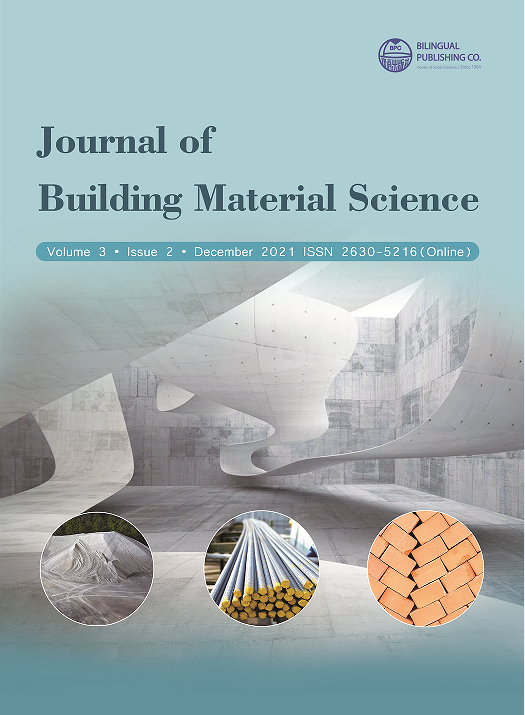
Partial Replacement of Cement by Solid Wastes as New Materials for Green Sustainable Construction Applications
DOI:
https://doi.org/10.30564/jbms.v3i2.3082Abstract
The manufacturing of ordinary Portland cement is an energy-intensive process that results in pollution and CO2 emissions, among other issues. There is a need for an environmentally friendly green concrete substitute. Waste products from a variety of sectors can be recycled and used as a green concrete substitute. This decreases the environmental effects of concrete manufacturing as well as energy consumption. The use of solid waste materials for green building is extremely important now and in the future. Green concrete is also in its infancy in terms of manufacturing and application. Academics must intervene by encouraging business implementation. The aim of this review paper is to raise awareness about the importance of repurposing recycled materials and to highlight new technologies for producing green, sustainable concrete.Keywords:
Construction materials; Sustainable composites; Green concrete; Solid wastesReferences
[1] B. A. Herki, J. M. Khatib, and E. M. Negim, “Lightweight concrete made from waste polystyrene and fly ash,” World Appl. Sci. J., vol. 21, no. 9, pp. 1356-1360, 2013.
[2] J. N. Asaad and S. Y. Tawfik, “Polymeric composites based on polystyrene and cement dust wastes,” Mater. Des., vol. 32, no. 10, pp. 5113-5119, 2011.
[3] M. H. Wills Jr, “Concrete masonry units incorporating cement kiln dust.” Google Patents, Oct. 04, 1983.
[4] P. L. N. Fernando, M. T. R. Jayasinghe, and C. Jayasinghe, “Structural feasibility of Expanded Polystyrene (EPS) based lightweight concrete sandwich wall panels,” Constr. Build. Mater., vol. 139, pp. 45-51, 2017.
[5] F. Pelisser, A. Barcelos, D.Santos, M.Peterson, and A.M.Bernardin,“Lightweight concrete production with low Portland cement consumption,”J. Clean. Prod.,vol.23, no.1, pp.68-74, 2012.
[6] J.A.Bogas, M.G.Gomes,and A.Gomes,“Compressive strength evaluation of structural lightweight concrete by non-destructive ultrasonic pulse velocity method,”Ultrasonics,vol.53,no.5,pp.962-972, 2013.
[7] K. Gunasekaran and P. S. Kumar, “Lightweight concrete using coconut shell as aggregate,” in Proceedings of the ICACC-2008. International conference on advances in concrete and construction, Hyderabad, India, 2008, pp. 7-9.
[8] H.M.Saleh,A.A.Salman,A.A.Faheim, and A.M.El-Sayed,“Sustainable composite of improved lightweight concrete from cement kiln dust with grated poly (styrene),”J. Clean.Prod.,p. 123491,2020.
[9] X. Shi, N. Xie, K. Fortune, and J. Gong, “Durability of steel reinforced concrete in chloride environments: An overview,” Constr. Build. Mater., vol. 30, pp. 125-138, 2012.
[10] Z. Giergiczny, “Fly ash and slag,” Cem. Concr. Res., vol. 124, p. 105826, 2019.
[11] S.Demirdag,“Effects of freezing-thawing and thermal shock cycles on physical and mechanical properties of filled and unfilled travertines,”Constr. Build. Mater.,vol.47, pp.1395-1401,2013.
[12] M. Schneider, M.Romer,M.Tschudin,and H.Bolio,“Sustainable cement production—present and future,”Cem. Concr. Res.,vol.41,no.7,pp.642-650,2011.
[13] M.S.Imbabi,C.Carrigan,and S.McKenna,“Trends and developments in green cement and concrete technology,”Int. J. Sustain. Built Environ.,vol.1,no.2,pp.194-216,2012.
[14] U. N. Environment, K. L. Scrivener, V. M. John, and E. M. Gartner, “Eco-efficient cements: Potential economically viable solutions for a low-CO2 cement-based materials industry,” Cem. Concr. Res., vol. 114, pp. 2-26, 2018.
[15] P. K. Gupta, “Toxicologic Hazards of Solvents, Gases, Vapors, and Other Chemicals,” in Concepts and Applications in Veterinary Toxicology, Springer, 2019, pp. 121-142.
[16] L. Zhang, J. Wu, and H. Liu, “Turning green into gold: A review on the economics of green buildings,” J. Clean. Prod., vol. 172, pp. 2234-2245, 2018.
[17] A. Alwisy, S. BuHamdan, and M. Gül, “Criteria-based ranking of green building design factors according to leading rating systems, ” Energy Build., vol. 178, pp. 347-359, 2018.
[18] M. M. Hossain, M. R. Karim, M. Hasan, M. K. Hossain, and M. F. M. Zain, “Durability of mortar and concrete made up of pozzolans as a partial replacement of cement: A review,” Constr. Build. Mater., vol. 116, pp. 128-140, 2016.
[19] S. Donatello, A. Palomo, and A. Fernández-Jiménez, “Durability of very high volume fly ash cement pastes and mortars in aggressive solutions,” Cem. Concr. Compos., vol. 38, pp. 12-20, 2013.
[20] Z. A. Zeidabadi, S. Bakhtiari, H. Abbaslou, and A. R. Ghanizadeh, “Synthesis, characterization and evaluation of biochar from agricultural waste biomass for use in building materials,” Constr. Build. Mater., vol. 181, pp. 301-308, 2018.
[21] H. Moayedi, B. Aghel, H. Nguyen, and A. S. A. Rashid, “Applications of rice husk ash as green and sustainable biomass,” J. Clean. Prod., vol. 237, p. 117851, 2019.
[22] B.S.Thomas, “Green concrete partially comprised of rice husk ash as a supplementary cementitious material-A comprehensive review,”Renew. Sustain. Energy Rev.,vol.82,pp.3913-3923,2018.
[23] C. Sonat and C. Unluer, “Development of magnesium-silicate-hydrate (MSH) cement with rice husk ash,” J. Clean. Prod., vol. 211, pp. 787-803, 2019.







 Hosam M. Saleh
Hosam M. Saleh





